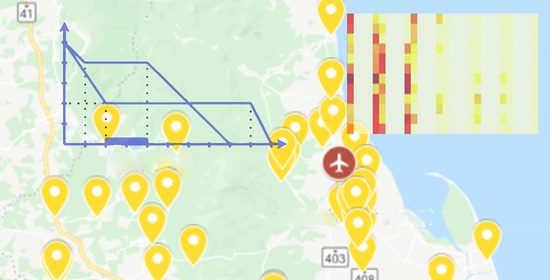Spectrum Occupancy Model Based on Empirical Data for FM Radio Broadcasting in Suburban Environments
Abstract
1. Introduction
- to devise the implementation of Reference [31]’s concept for analyzing the decision threshold with empirical data,
- to improve the accuracy in evaluating the spectrum occupancy of FM radio public bands by the proposed measurement strategies and threshold designation, as well as to gain insights into why the proposed strategies offer higher accuracy than the existing strategies,
- to gain insight into the pattern of spectrum occupancy of FM radio public bands in suburban areas, and
- to identify the channels, which cause interference, and the channels, which are affected by the interference.
2. Measurement Location
3. Measurement Setup
3.1. Measurement Strategy
3.2. Measurement System
3.2.1. Sensing Setup
3.2.2. Data Processing
4. Decision Threshold Selection Criteria, Occupancy Classification Criteria, and Interference Criteria
4.1. Decision Thresholds in Previous Works
4.2. Proposed Implementation
4.2.1. Creating Spectrum Density Map
4.2.2. Creating Channel Occupancy Map
4.2.3. Modeling Channel Occupancy
- A channel has strong activity if its curve has constant occupation percentage while the value of is between zero and one.
- A channel has a good activity if its curve has constant occupation percentage while the value of equals one.
- A channel has no activity if its curve has constant occupation percentage while the value of is zero.
- A channel has weak activity if its curve has constant occupation percentage over many intervals.
4.3. Results
4.3.1. Spectrum Density Map
4.3.2. Channel Occupancy Map
4.3.3. Curves of Duty Cycle
4.4. Occupancy Classification Criteria
- A channel is used normally if and ;
- A channel is used abnormally if ;
- A channel is unused normally if and ;
- A channel is unused abnormally if .
4.5. Interference Criteria
4.5.1. Interfered Channel Criteria
- A channel is interfered from adjacent channels if ;
- A channel is interfered from unknown sources if otherwise.
4.5.2. Interference Source Criteria
- A channel is an obvious interference source channel that interfere its adjacent channels if ;
- A channel is an unobvious interference source channel if otherwise.
5. Insight of Spectrum Utilization
5.1. Evaluation of Channel Occupancy
5.2. Evaluation of Channel Usage
5.3. Interfered Channels
5.4. Interference Source Criteria
6. Conclusions
Author Contributions
Funding
Institutional Review Board Statement
Informed Consent Statement
Data Availability Statement
Acknowledgments
Conflicts of Interest
References
- Zulfiqar, M.D.; Ismail, K.; Hassan, N.U.; Hussain, S.; Zhang, M. Radio spectrum occupancy measurement from 30 MHz–1030 MHz in Pakistan. In Proceedings of the International Conference on UK—China Emerging Technologies (UCET 2019), Glasgow, UK, 21–22 August 2019; pp. 1–5. [Google Scholar]
- Dzulkifli, M.R.; Kamarudin, M.R.; Rahman, T.A. Spectrum occupancy of Malaysia radio environment for cognitive radio application. In Proceedings of the IET International Conference on Wireless Communications and Applications (ICWCA 2012), Kuala Lumpur, Malaysia, 8–10 October 2012; pp. 1–6. [Google Scholar]
- Dzulkifli, M.R.; Kamarudin, M.R.; Tharek, A.R. Spectrum occupancy at UHF TV band for cognitive radio applications. In Proceedings of the 2011 IEEE International RF & Microwave Conference, Seremban, Malaysia, 12–14 December 2011; pp. 111–114. [Google Scholar]
- Chen, D.; Yang, J.; Wu, J.; Tang, H.; Huang, M. Spectrum occupancy analysis based on radio monitoring network. In Proceedings of the 2012 1st IEEE International Conference on Communications in China (ICCC), Beijing, China, 15–17 August 2012; pp. 739–744. [Google Scholar]
- Patil, K.; Skouby, K.; Chandra, A.; Prasad, R. Spectrum occupancy statistics in the context of cognitive radio. In Proceedings of the 2011 the 14th International Symposium on Wireless Personal Multimedia Communications (WPMC), Brest, France, 18 November 2011; pp. 1–5. [Google Scholar]
- Marcu, I.; Marghescu, I.; Maniu, I. Evaluation of Spectrum Occupancy in an Urban Environment in a Cognitive Radio Context. Int. J. Adv. Telecommun. 2010, 3, 172–181. [Google Scholar]
- Lopez-Benitez, M.; Umbert, A.; Casadevall, F. Evaluation of spectrum occupancy in Spain for cognitive radio applications. In Proceedings of the VTC Spring 2009—IEEE 69th Vehicular Technology Conference, Barcelona, Spain, 12 June 2009; pp. 1–5. [Google Scholar]
- Islam, M.H.; Koh, C.L.; Oh, S.W.; Qing, X.; Lai, Y.Y.; Wang, C.; Liang, Y.-C.; Toh, B.E.; Chin, F.; Tan, G.L.; et al. Spectrum survey in Singapore: Occupancy measurements and analyses. In Proceedings of the 2008 3rd International Conference on Cognitive Radio Oriented Wireless Networks and Communications (CrownCom 2008), Singapore, 15–17 May 2008; pp. 1–7. [Google Scholar]
- Mchenry, M.A.; Tenhula, P.A.; McCloskey, D.; Roberson, D.A.; Hood, C.S. Chicago spectrum occupancy measurements & analysis and a long-term studies proposal. In Proceedings of the First International Workshop on Technology and Policy for Accessing Spectrum, Boston, MA, USA, 5 August 2006. [Google Scholar]
- Shared Spectrum Company. General Survey of Radio Frequency Bands—30 MHz to 3 GHz. Available online: https://www.sharedspectrum.com/wp-content/uploads/2010_0923-General-Band-Survey-30MHz-to-3GHz.pdf (accessed on 1 April 2021).
- Barlee, K.W.; Stewart, R.W.; Crockett, L.H.; MacEwen, N.C. Rapid Prototyping and Validation of FS-FBMC Dynamic Spectrum Radio with Simulink and ZynqSDR. IEEE Open J. Commun. Soc. 2021, 2, 113–131. [Google Scholar] [CrossRef]
- Barlee, K.W.; Stewart, R.W.; Crockett, L.H. Secondary user access for IoT applications in the FM radio band using FS-FBMC. In Proceedings of the 2018 IEEE 5G World Forum (5GWF), Silicon Valley, CA, USA, 1 November 2018; pp. 468–473. [Google Scholar]
- Shaikhah, S.K.; Mustafa, S. A robust filter bank multicarrier system as a candidate for 5G. Phys. Commun. 2020, 43, 1–13. [Google Scholar] [CrossRef]
- Otermat, D.T.; Kostanic, I.; Otero, C.E. Analysis of the FM Radio Spectrum for Secondary Licensing of Low-Power Short-Range Cognitive Internet of Things Devices. IEEE Access 2016, 4, 6681–6691. [Google Scholar] [CrossRef]
- Baek, M.; Ju, S.; Lim, H.; Yang, K.; Lee, B.; Kim, K. Channel Allocation and Interference Analysis for DAB System in Frequency Band III Environment With Legacy T-DMB. IEEE Trans. Broadcast. 2016, 62, 962–970. [Google Scholar] [CrossRef]
- Fang, S.; Chen, J.; Huang, H.; Lin, T. Is FM a RF-Based Positioning Solution in a Metropolitan-Scale Environment? A Probabilistic Approach With Radio Measurements Analysis. IEEE Trans. Broadcast. 2009, 55, 577–588. [Google Scholar] [CrossRef]
- Haralambous, H.; Papadopoulos, H. 24-Hour Neural Network Congestion Models for High-Frequency Broadcast Users. IEEE Trans. Broadcast. 2009, 55, 145–154. [Google Scholar] [CrossRef]
- Mustaqeem; Soonil, K. Att-Net: Enhanced emotion recognition system using lightweight self-attention module. Appl. Soft Comput. 2021, 102, 1–11. [Google Scholar] [CrossRef]
- Rysavy, P. Challenges and Considerations in Defining Spectrum Efficiency. Proc. IEEE 2014, 102, 386–392. [Google Scholar] [CrossRef]
- Matheson, R.J. Strategies for spectrum usage measurements. In Proceedings of the IEEE 1988 International Symposium on Electromagnetic Compatibility, Seattle, WA, USA, 2–4 August 1988; pp. 235–241. [Google Scholar]
- Höyhtyä, M.; Mämmelä, A.; Eskola, M.; Matinmikko, M.; Kalliovaara, J.; Ojaniemi, J.; Suutala, J.; Ekman, R.; Bacchus, R.; Roberson, D. Spectrum Occupancy Measurements: A Survey and Use of Interference Maps. IEEE Commun. Surv. Tutor. 2016, 18, 2386–2414. [Google Scholar] [CrossRef]
- Chen, Y.; Oh, H. A Survey of Measurement-Based Spectrum Occupancy Modeling for Cognitive Radios. IEEE Commun. Surv. Tutor. 2016, 18, 848–859. [Google Scholar] [CrossRef]
- Saleem, Y.; Rehmani, M.H. Primary Radio User Activity Models for Cognitive Radio Networks: A Survey. J. Netw. Comput. Appl. 2014, 43, 1–16. [Google Scholar] [CrossRef]
- Yucek, T.; Arslan, H. A Survey of Spectrum Sensing Algorithms for Cognitive Radio Applications. IEEE Commun. Surv. Tutor. 2009, 11, 116–130. [Google Scholar] [CrossRef]
- Yilmaz, H.B.; Tugcu, T. Location Estimation-based Radio Environment Map Construction in Fading Channels. Wirel. Commun. Mob. Comput. 2015, 15, 561–570. [Google Scholar] [CrossRef]
- Phillips, C.; Ton, M.; Sicker, D.; Grunwald, D. Practical radio environment mapping with geostatistics. In Proceedings of the 2012 IEEE International Symposium on Dynamic Spectrum Access Networks, Bellevue, WA, USA, 16–19 October 2012; pp. 422–433. [Google Scholar]
- Yilmaz, H.B.; Tugcu, T.; Alagöz, F.; Bayhan, S. Radio environment map as enabler for practical cognitive radio networks. IEEE Commun. Mag. 2013, 51, 162–169. [Google Scholar] [CrossRef]
- Angjelicinoski, M.; Atanasovski, V.; Gavrilovska, L. Comparative analysis of spatial interpolation methods for creating radio environment maps. In Proceedings of the 2011 19th Telecommunications Forum (TELFOR) Proceedings of Papers, Belgrade, Serbia, 2 February 2012; pp. 334–337. [Google Scholar]
- Willkomm, D.; Machiraju, S.; Bolot, J.; Wolisz, A. Primary Users in Cellular Networks: A Large-Scale Measurement Study. In Proceedings of the 2008 3rd IEEE Symposium on New Frontiers in Dynamic Spectrum Access Networks, Chicago, IL, USA, 24 October 2008; pp. 1–11. [Google Scholar]
- Lopez-Benitez, M.; Casadevall, F. Methodological aspects of spectrum occupancy evaluation in the context of cognitive radio. In Proceedings of the 2009 European Wireless Conference, Aalborg, Denmark, 28 December 2009; pp. 199–204. [Google Scholar]
- Jones, S.D.; Jung, E.; Liu, X.; Merheb, N.; Wang, I. Characterization of Spectrum Activities in the U.S. Public Safety Band for Opportunistic Spectrum Access. In Proceedings of the 2007 2nd IEEE International Symposium on New Frontiers in Dynamic Spectrum Access Networks, Dublin, Ireland, 17–20 April 2007; pp. 137–146. [Google Scholar]
- Mitola, J. Cognitive Radio: An Integrated Agent Architecture for Software Defined Radio. Ph.D. Thesis, KTH Royal Institute of Technology, Stockholm, Sweden, 2000. [Google Scholar]
- Losada, S.A.; Quiceno, R.A.; Pérez, M.; Paéz, C.I. Opportunistic Communication System for the FM Band. In Proceedings of the 2018 IEEE-APS Topical Conference on Antennas and Propagation in Wireless Communications (APWC), Cartagena des Indias, Colombia, 10–14 September 2018; pp. 890–896. [Google Scholar]
- Eduardo, A.F.; González Caballero, R.G. Experimental evaluation of performance for spectrum sensing: Matched filter vs energy detector. In Proceedings of the IEEE Colombian Conference on Communication and Computing (IEEE COLCOM 2015), Popayan, Colombia, 13–15 May 2015; pp. 1–6. [Google Scholar]
- Lopez-Benitez, M.; Casadevall, F. A radio spectrum measurement platform for spectrum surveying in cognitive radio. In Proceedings of the 7th International ICST Conference (TridentCom 2011), Shanghai, China, 17–19 April 2011; pp. 1–16. [Google Scholar]
- Patil, K.; Barge, S.; Skouby, K.; Prasad, R. Evaluation of spectrum usage for GSM band in indoor and outdoor scenario for Dynamic Spectrum Access. In Proceedings of the 2013 International Conference on Advances in Computing, Communications and Informatics (ICACCI), Mysore, India, 21 October 2013; pp. 655–660. [Google Scholar]
- Weidling, F.; Datla, D.; Petty, V.; Krishnan, P.; Minden, G.J. A framework for R.F. spectrum measurements and analysis. In Proceedings of the First IEEE International Symposium on New Frontiers in Dynamic Spectrum Access Networks (DySPAN 2005), Baltimore, MD, USA, 8–11 November 2005; pp. 573–576. [Google Scholar]
- Rice, S.O. Mathematical Analysis of Random Noise. Bell Syst. Tech. J. 1945, 24, 46–156. [Google Scholar] [CrossRef]
- Jones, R.W. International Telecommunication Union (ITU). Available online: https://extranet.itu.int/brdocsearch/R-HDB/R-HDB-23/R-HDB-23-2002/R-HDB-23-2002-OAS-PDF-E.pdf (accessed on 16 December 2002).
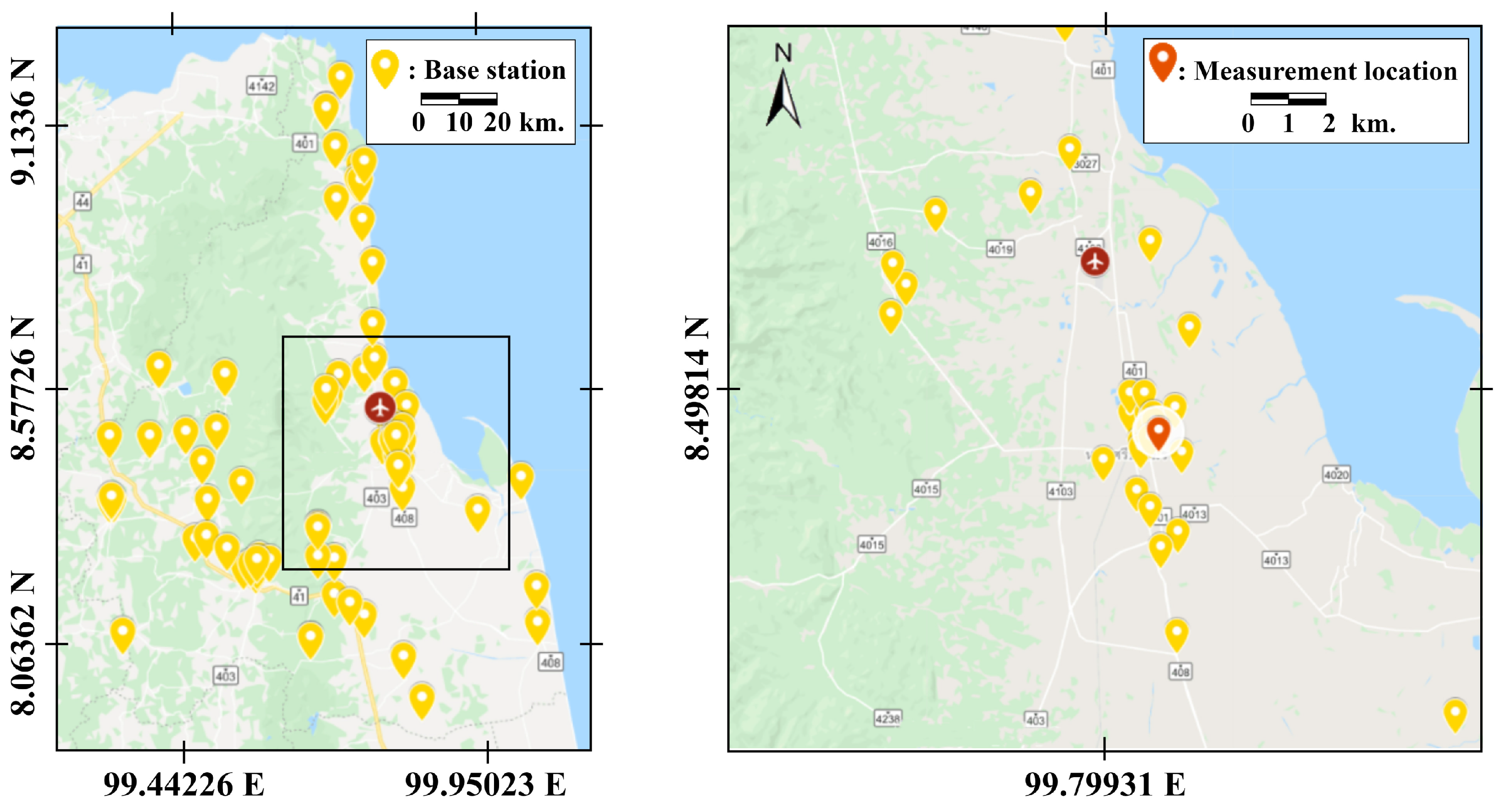
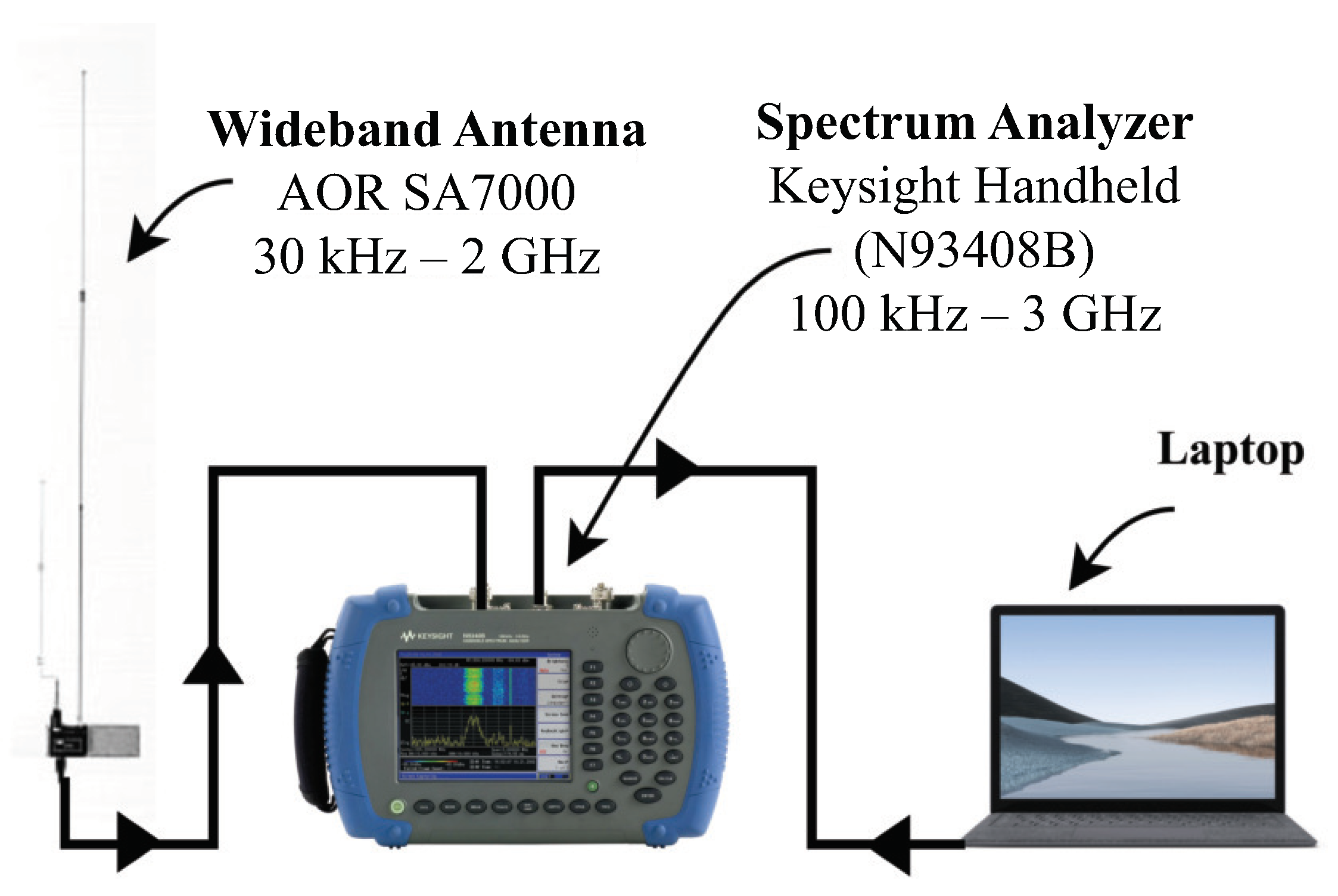
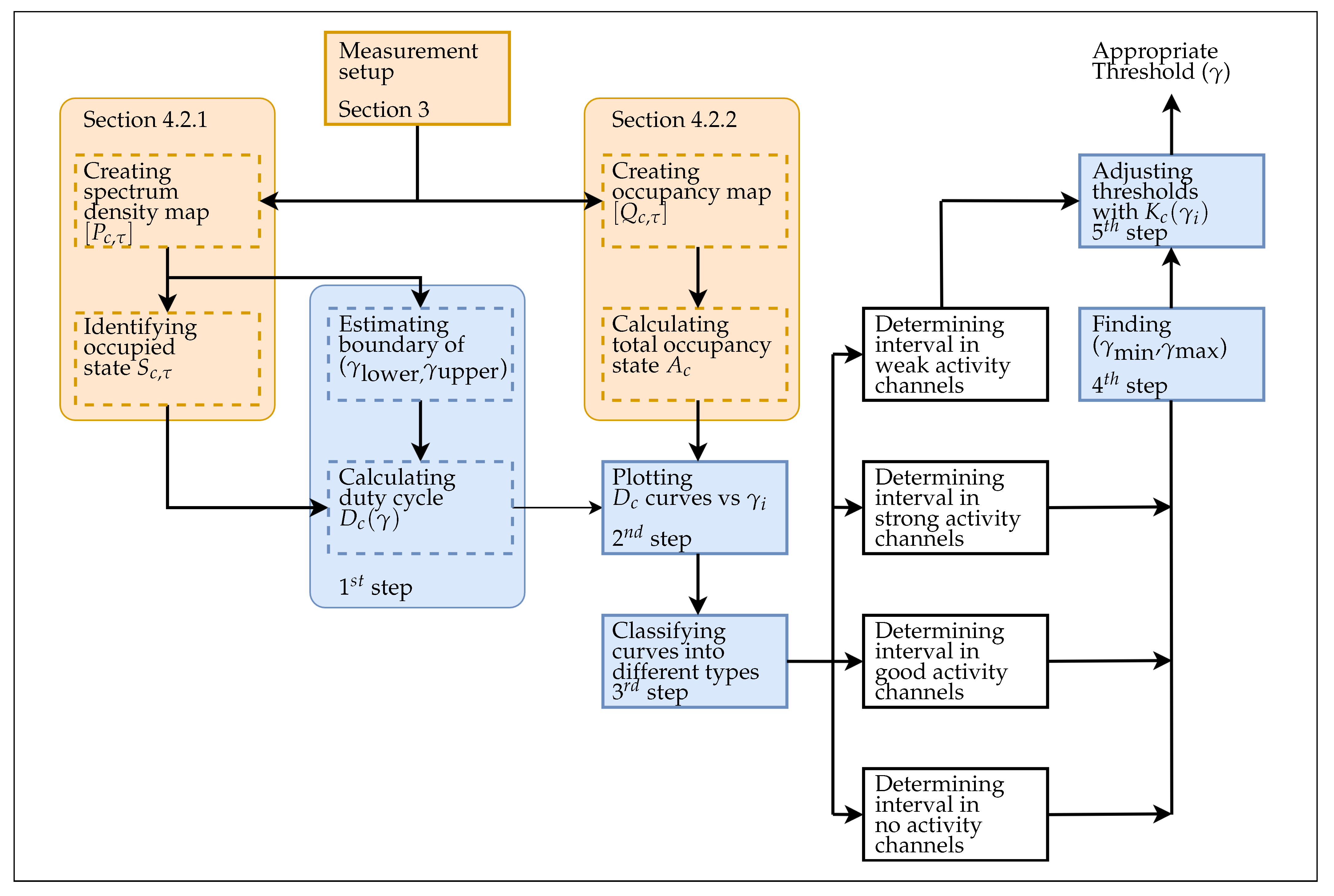
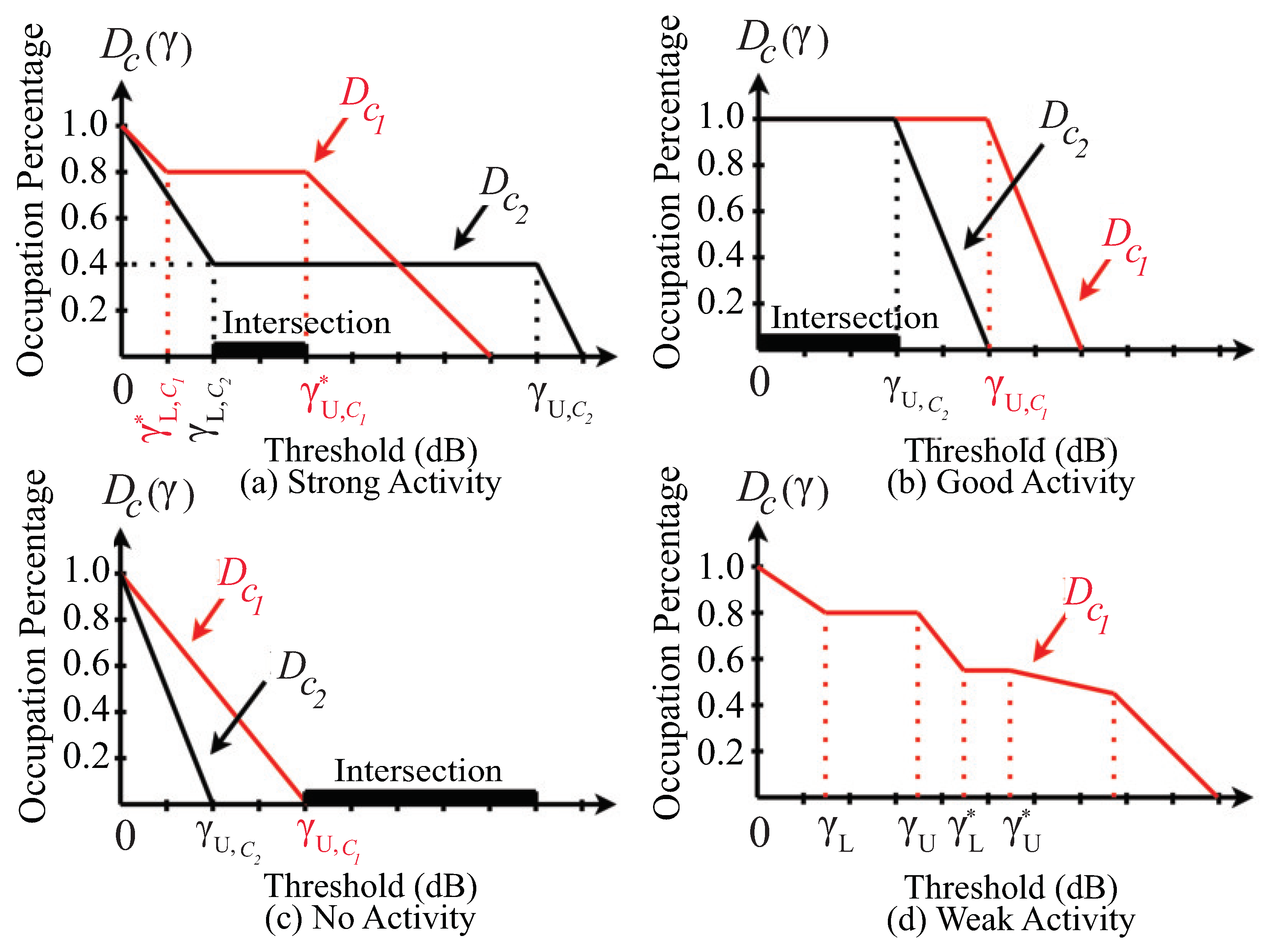
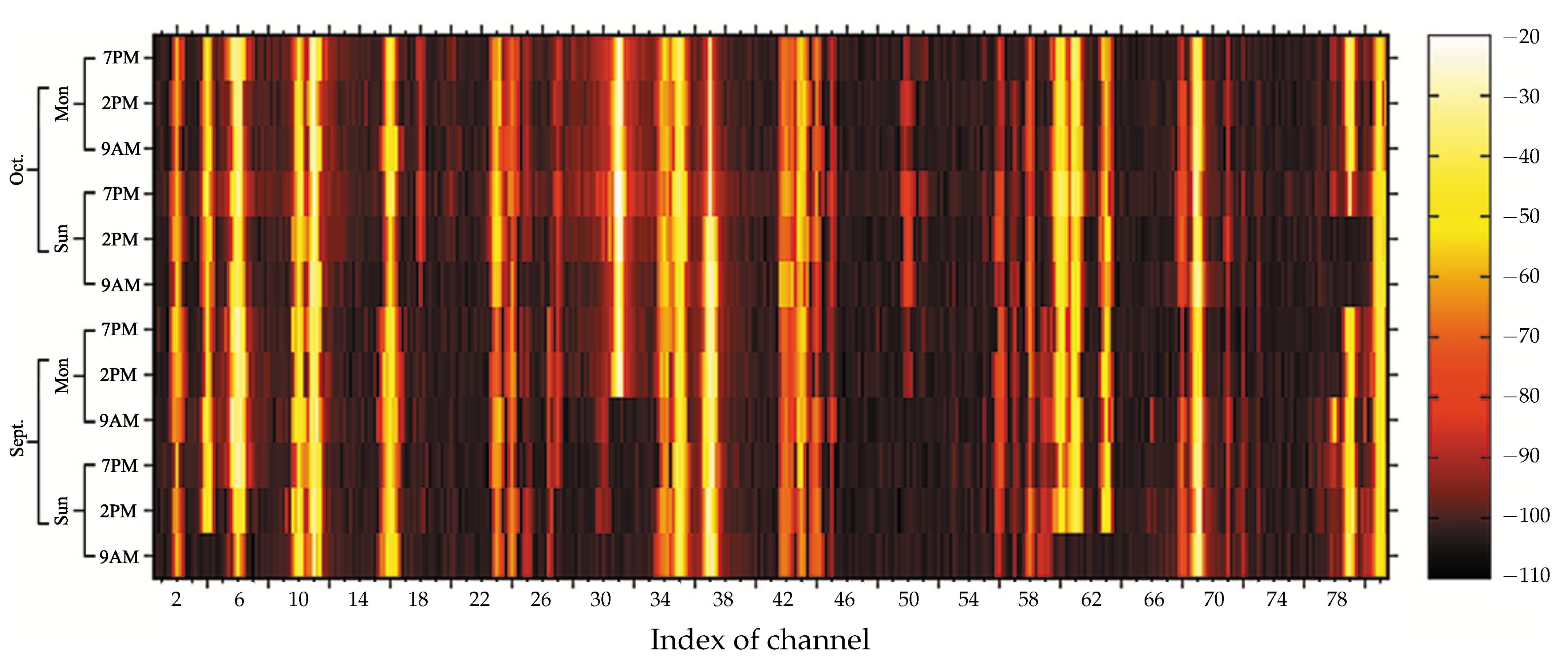
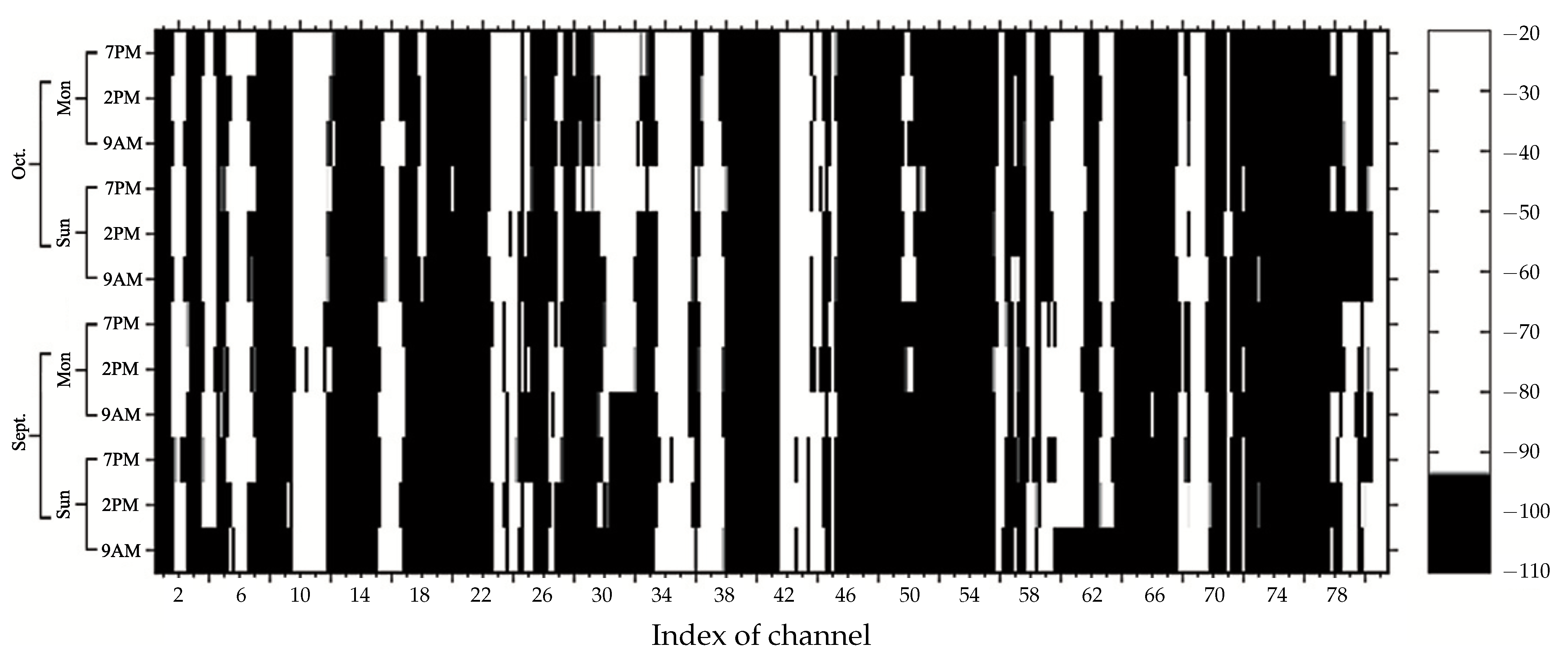
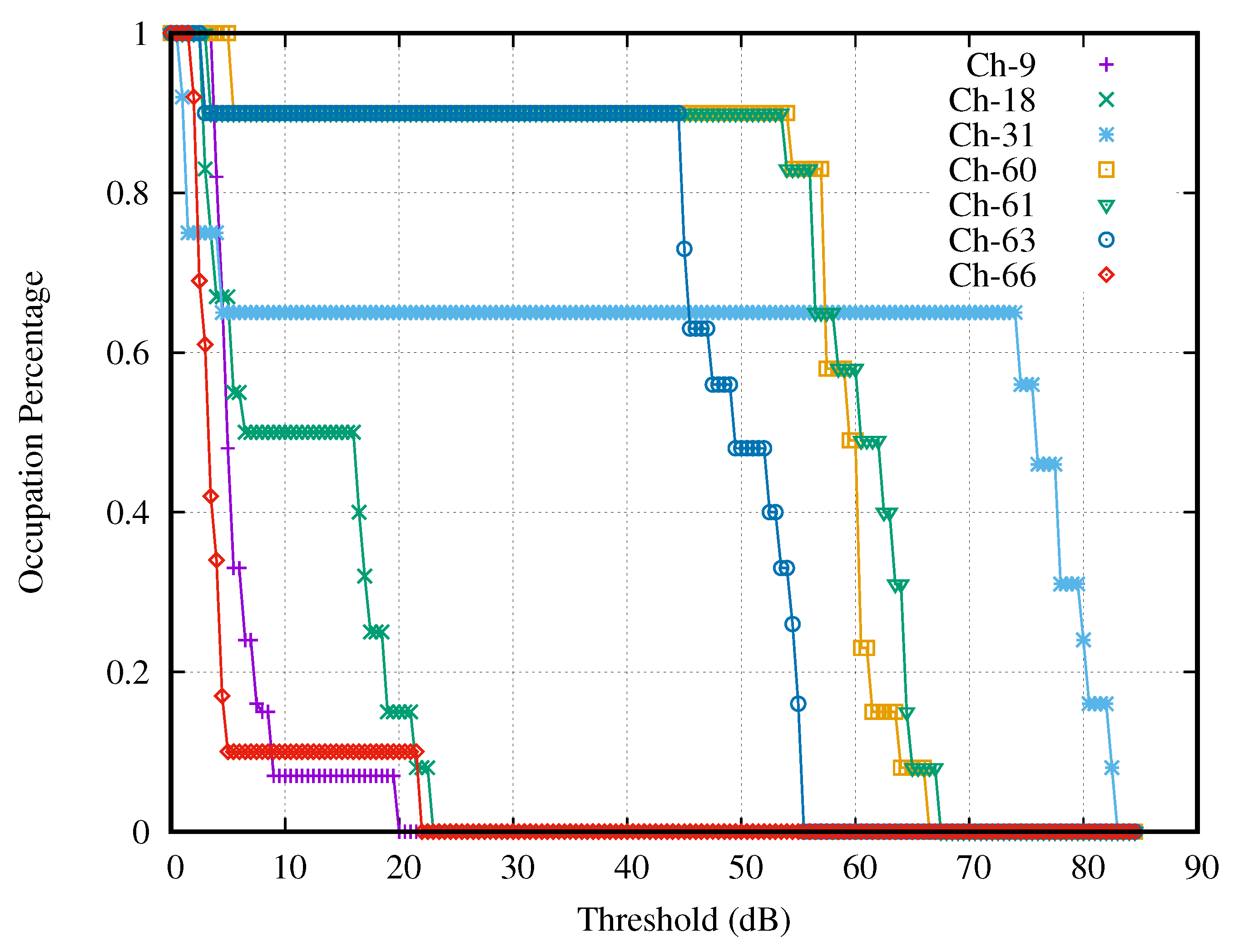
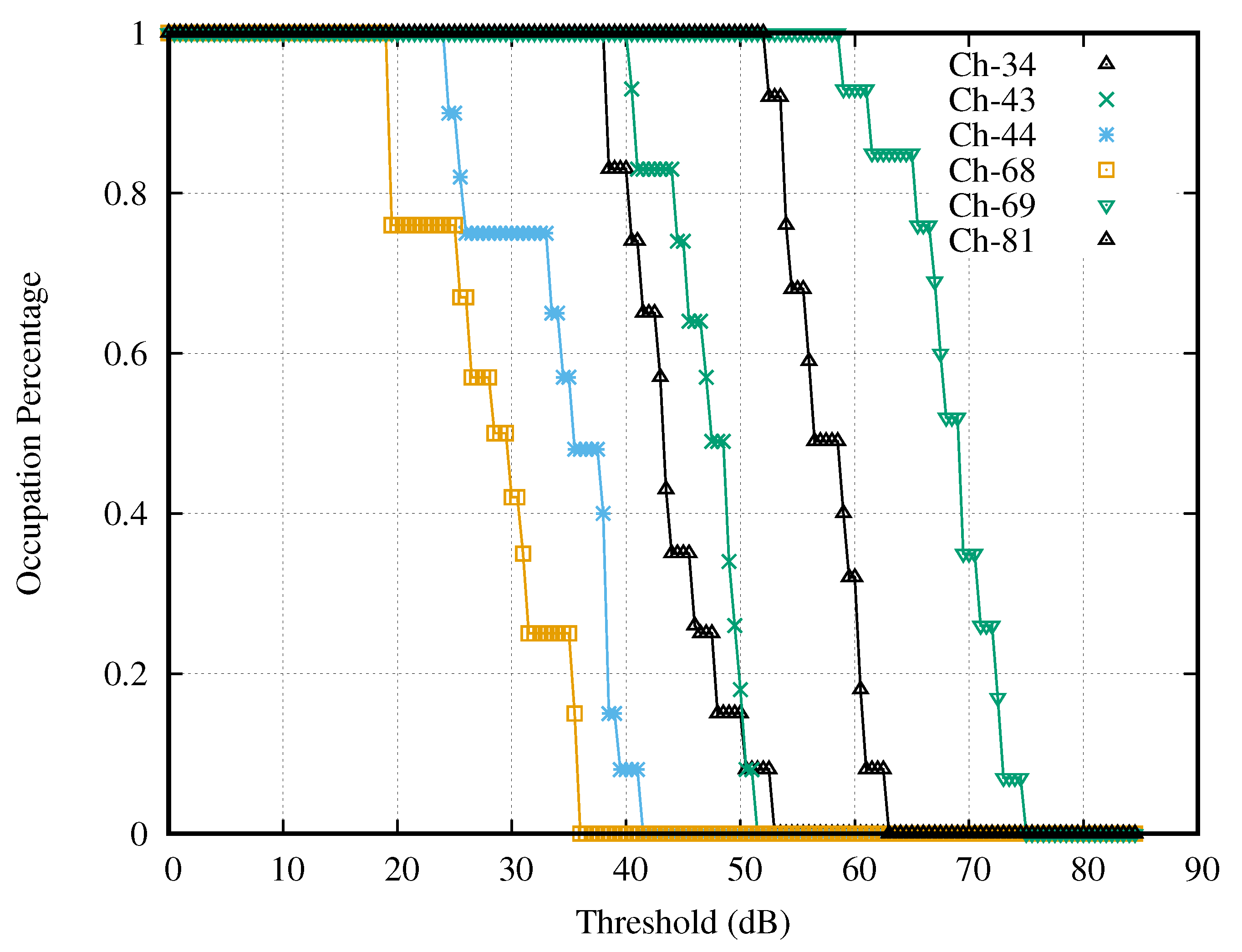
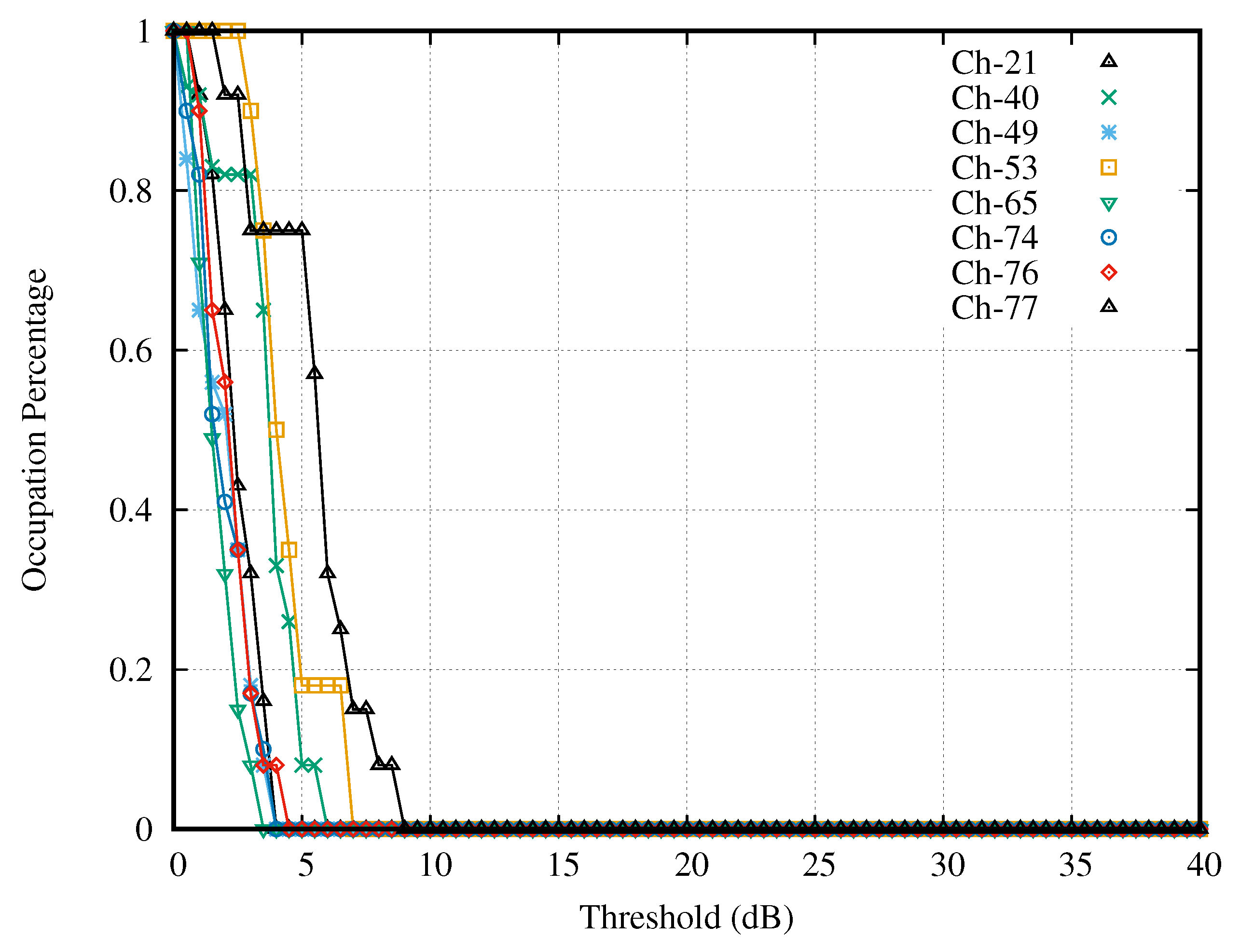
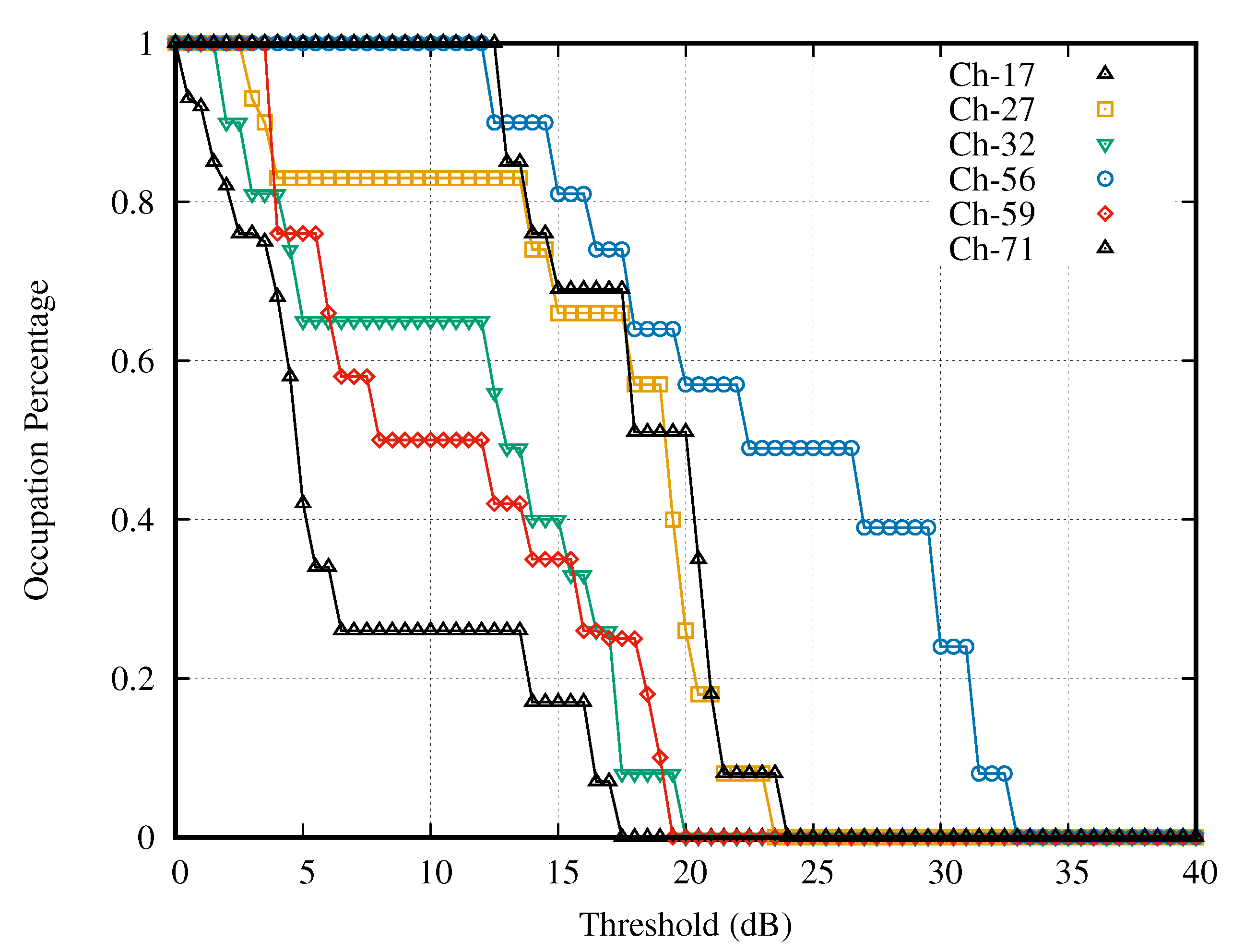
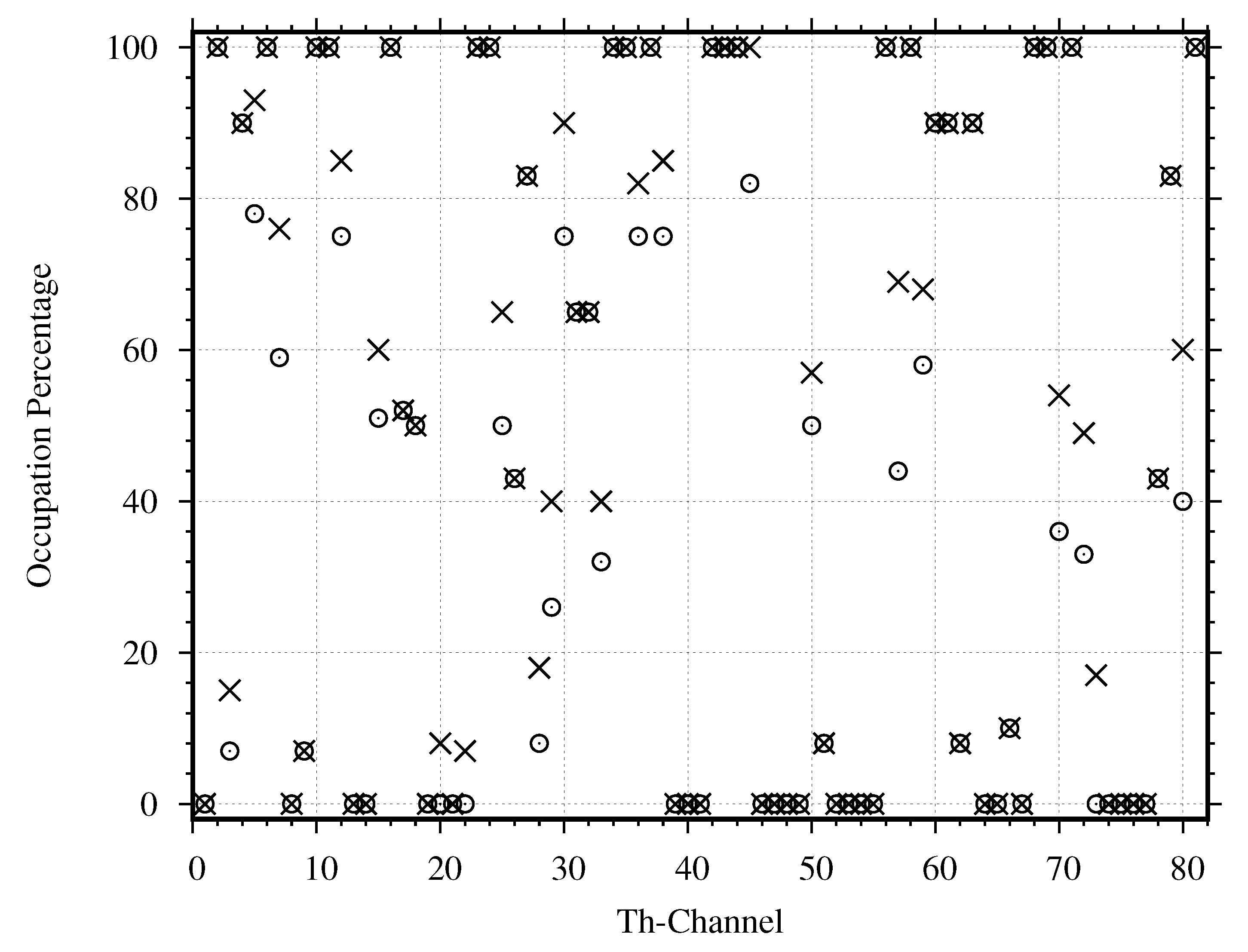
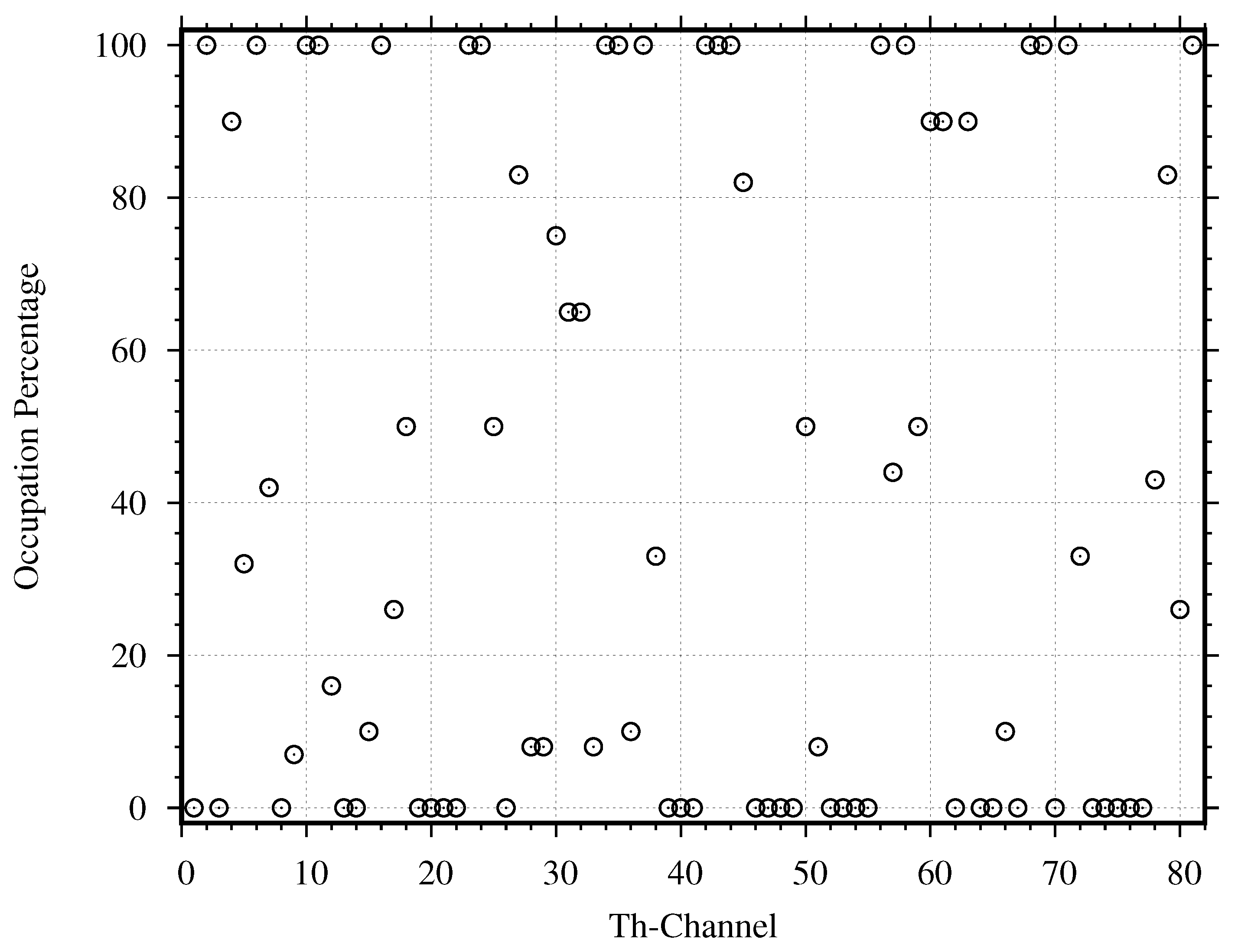
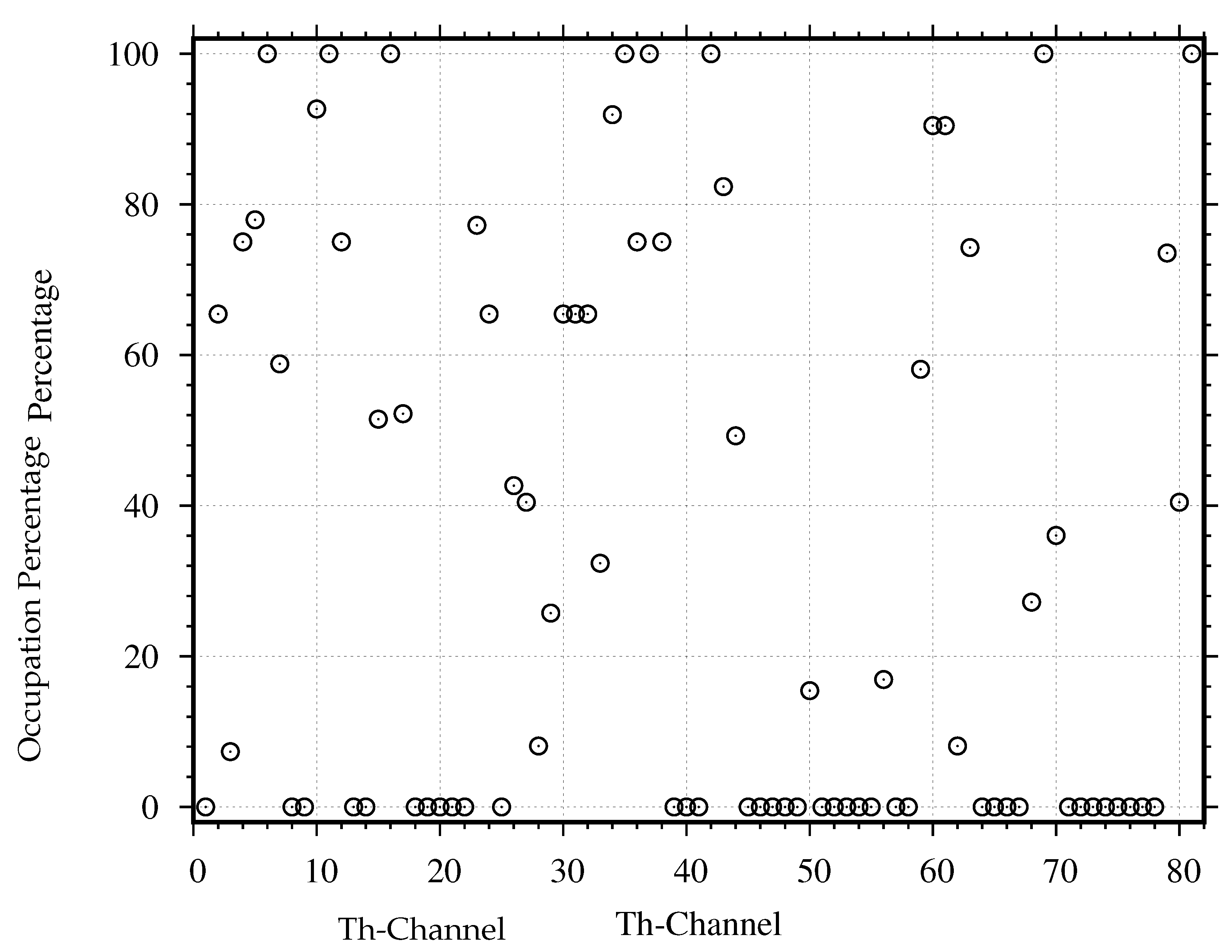
| 9.0 | 28 |
| 9.5 | 26 |
| 10.0 | 29 |
| 10.5 | 27 |
| 11.0 | 25 |
| 11.5 | 24 |
| 12.0 | 20 |
| 12.5 | 27 |
Publisher’s Note: MDPI stays neutral with regard to jurisdictional claims in published maps and institutional affiliations. |
© 2021 by the authors. Licensee MDPI, Basel, Switzerland. This article is an open access article distributed under the terms and conditions of the Creative Commons Attribution (CC BY) license (https://creativecommons.org/licenses/by/4.0/).
Share and Cite
Chantaveerod, A.; Woradit, K.; Pochaiya, C. Spectrum Occupancy Model Based on Empirical Data for FM Radio Broadcasting in Suburban Environments. Sensors 2021, 21, 4015. https://doi.org/10.3390/s21124015
Chantaveerod A, Woradit K, Pochaiya C. Spectrum Occupancy Model Based on Empirical Data for FM Radio Broadcasting in Suburban Environments. Sensors. 2021; 21(12):4015. https://doi.org/10.3390/s21124015
Chicago/Turabian StyleChantaveerod, Ajalawit, Kampol Woradit, and Charernkiat Pochaiya. 2021. "Spectrum Occupancy Model Based on Empirical Data for FM Radio Broadcasting in Suburban Environments" Sensors 21, no. 12: 4015. https://doi.org/10.3390/s21124015
APA StyleChantaveerod, A., Woradit, K., & Pochaiya, C. (2021). Spectrum Occupancy Model Based on Empirical Data for FM Radio Broadcasting in Suburban Environments. Sensors, 21(12), 4015. https://doi.org/10.3390/s21124015






